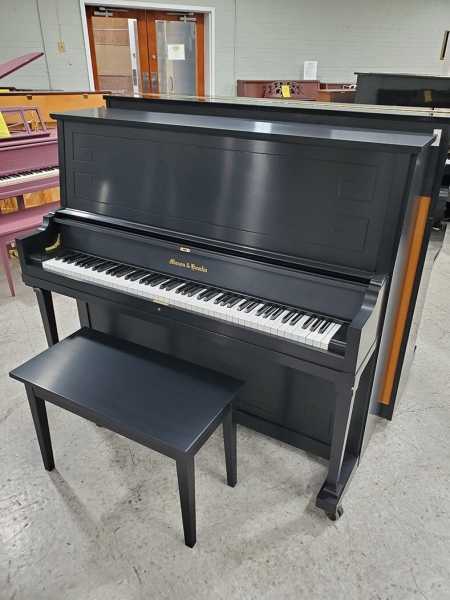

- #MASON AND HAMLIN UPRIGHT PIANO 1901 SERIAL#
- #MASON AND HAMLIN UPRIGHT PIANO 1901 UPDATE#
- #MASON AND HAMLIN UPRIGHT PIANO 1901 FULL#
The final part of our soundboard’s construction is a gradual tapering towards its edges.
#MASON AND HAMLIN UPRIGHT PIANO 1901 FULL#
By starting with a large radius in the treble and steadily reducing it towards the bass, our soundboard is uniquely optimized for both the high frequency of treble notes, which require a stiffer soundboard for clear projection, as well as the low frequency of bass notes, who favor a flexible soundboard for full response. This method allows us to precisely control the shape of each rib, and is what makes our Multi-Radius Crown Soundboard possible. Mason & Hamlin shapes the crown of our soundboards via cutting it directly into the ribs themselves. This shape takes the form of crown, and is what gives a piano its vibrancy, focus, and clarity.

While being constructed from the finest material is an excellent start, a soundboard must be properly shaped to take advantage of its potential. This particular type of tree is ideally suited for its role, and produces the most musical sound of any available material. These characteristics can be attributed to our choice of material-tight-grained, quarter-sawn Eastern White Spruce that is dried and aged to perfection. The Mason & Hamlin soundboard emanates a sound that can be described as both sweet and powerful, melodic and thunderous. It is the very heart of the instrument and essential to the unique voice of each piano. It is a thin, well-crafted piece of wood that, when subjected to vibrations of a string, is capable of producing the air pressure waves that we perceive as sound. The soundboard is the centerpiece of a piano‘s essence. This material is no stranger to fine instruments-Stradivarius used Hard Rock Maple in the back and sides of his violins for its strong, robust qualities. Richard Gertz specifically chose Hard Rock Maple for the Mason & Hamlin rim, and the Model 50 continues this tradition by using Hard Rock Maple for its back and sides.
#MASON AND HAMLIN UPRIGHT PIANO 1901 SERIAL#
Or, you may Contact Us, here to obtain your piano's age, based on its serial number, or you may request an Online Appraisal for the current private party value and the insurance replacement value of your piano.Material choice is extremely important when constructing a piano’s foundation.
#MASON AND HAMLIN UPRIGHT PIANO 1901 UPDATE#
Please check back after for an update of piano serial numbers, for this manufacturer. It feels to play a quality yet truly affordable piano.

Means that you should try one out, if you truly wish to experience how With all the best there is with George Steck pianos, it only Sound 'smoother': the soundboard area greatly affects and More lively area of the soundboard, so much for a smoother transition in This makes it easier for the bridges to be placed near to the George Steck grand pianos are distinct for their wide tailĭesign. Add to this, grand piano rims are made of maple, just the same as Steinway uses for its grand piano rims. Pianos indeed more valuable, for the money spent. To offer pianos that are identical in materials to those manufacturedīy large Japanese makers at a more affordable price. George Steck pianos larger than 5’4” are manufactured with a duplex scale Each piano is made with a Vacuum Cast plate like Yamaha and Kawai. Its hammers are made from Japan, while strings are made in Germany, something that its closest competitors cannot brag about. The pianosĪre an assembly of the best that Asia and Europe has to offer. Tapered sounding boards that release a clear ringing tone. New generation George Steck pianos are known for their specially Sold at a quality close to those made by Yamaha and Kawai, albeit at a Pianos with greater depth and character were manufactured and Korean conglomerate Sejung, purchased the company, and went global, with the aid of the conglomerate’s resources. The assets of George Steck became a part of the Mason & Hamlin Corporation, before George Steck pianos ceased production in 1994.Īlthough George Steck may have long been deceased, his company A few short years later in 1904, the company became part of the Aeolian Company, and in 1932, the Aeolian American Company. George Steck passed away in 1897, and the company incorporated at that time.


 0 kommentar(er)
0 kommentar(er)
